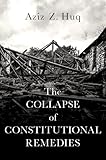The Collapse of Constitutional Remedies / Aziz Z. Huq.
Series: Inalienable rightsPublisher: New York : Oxford University Press, [2021]Description: pages cmContent type:- text
- unmediated
- volume
- 9780197556818
- 342.73088 HUQ 23
- KF1306.C64 H87 2021
| Item type | Current library | Shelving location | Call number | Status | Date due | Barcode |
|---|---|---|---|---|---|---|
 BOOKs
BOOKs
|
National Law School | General Stacks | 342.73088 HUQ (Browse shelf(Opens below)) | Available | 38626 |
Includes index.
Table of Contents
Acknowledgements;
Introduction;
Chapter 1: Blueprint;
Chapter 2: Building;
Chapter 3: Remedies;
Chapter 4: Collapse;
Chapter 5: Remains;
Coda;
Notes;
Index
"This book describes and explains the failure of the federal courts of the United States to act and to provide remedies to individuals whose constitutional rights have been violated by illegal state coercion and violence. This remedial vacuum must be understood in light of the original design and historical development of the federal courts. At its conception, the federal judiciary was assumed to be independent thanks to an apolitical appointment process, a limited supply of adequately trained lawyers (which would prevent cherry-picking), and the constraining effect of laws and constitutional provision. Each of these checks quickly failed. As a result, the early federal judicial system was highly dependent on Congress. Not until the last quarter of the nineteenth century did a robust federal judiciary start to emerge, and not until the first quarter of the twentieth century did it take anything like its present form. The book then charts how the pressure from Congress and the White House has continued to shape courts behaviour-first eliciting a mid-twentieth-century explosion in individual remedies, and then driving a five-decade long collapse. Judges themselves have not avidly resisted this decline, in part because of ideological reasons and in part out of institutional worries about a ballooning docket. Today, as a result of these trends, the courts are stingy with individual remedies, but aggressively enforce the so-called "structural" constitution of the separation of powers and federalism. This cocktail has highly regressive effects, and is in urgent need of reform"-- Provided by publisher.

There are no comments on this title.